NON MED models
1/50
There's no tags or description
Looks like no tags are added yet.
Name | Mastery | Learn | Test | Matching | Spaced |
|---|
No study sessions yet.
51 Terms
Rowe and Kahn’s model
Rowe and Kahn defined successful aging as ‘high physical, psychological, and social functioning in old age without major diseases’
Three main components:
Low probability of disease and disease related disability.
Refers to less disease and less risk of disease.
High cognitive and physical functional capacity.
Includes both physical and cognitive capacities and potential for activity.
Tell us what a person CAN do not what they DO do.
Active engagement with life.
Interpersonal relations – contacts and transactions with others and exchange of information.
Productive activity – an activity is productive if it creates societal value.
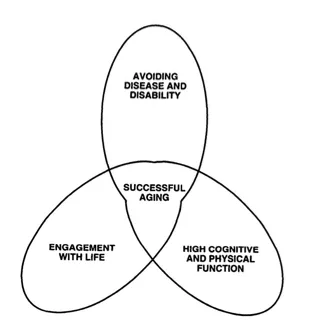
Biomedical model for successful aging
Optimising life expectancy and minimising physical and mental deterioration.
Importance of maintaining good health, no chronic conditions and maintaining independence.
Focus on how your body is able to adapt to aging.
Biopsychosocial Model for successful aging
Outcomes of one’s development over life and their ability to grow.
Importance of life satisfaction, personal growth and psychological resources.
Focus on what you get out of life – have you lived a good life?
Fair Innings Theory
Pros - Older people want to look ‘youthful’ – invest in botox, relief of symptoms of menopause, treatment for baldness etc.
Cons - Risk of infection upon hospitalisation, inappropriate use of tranquilisers, overprescribing
BREAKING BAD NEWS - SPIKES
S – Set up the consultation
Private, uninterrupted, sat down, warm, offer tissues at the side, and be attentive and ready to listen
P – Perception
Establish the patient’s perception and their understanding so far, ask how the patient is feeling, if they need to time to register the information.
I – Invitation
How much to they want to know? Invite them to ask questions
K – Knowledge and Information
Avoid using jargon, understand how much the patient knows and go off that, check the patient’s understanding
E – Emotion
Be empathetic, don’t downplay it and make sure to validate their emotions.
S – Summarise
Check understanding and make a plan
GROUNDED THEORY RESEARCH
Inductive research approach where you have a question or a bunch of qualitative data and you need to develop a hypothesis from it.
Formation of new theories using qualitative data.
Findings tightly connected to data.
Great for new theories.
Offers strategy for analysis.
Stops confirmation bias.
Difficulty collecting data.
Long process.
6 key hurdles for psychological adjustment to bad news
-managing uncertainty
-looking for meaning
-dealing w/ loss of control
-having a need for openness
-needs for emotional support
-needs for medical support
Substantive Theory of Caregiving
Purpose of caregiving varies over time
Gives insight into when and how family caregivers accept, reject or seek assistance with their caregiving efforts.
Purpose of caregiving related to decisions about maintaining, sharing, relinquishing care and accepting/rejecting help
Focuses on:
WHO is going to provide care (formal vs informal caregivers)
WHERE the care is going to be provided (home, day centre, nursing home)
HOW the care is going to be provided (exclusive to family or shared/delegated roles)
Outlined that caregivers went through two phases: interrelational and pragmatic – not necessarily in a linear format.
Interrelational phase happened early on and focused a lot more on what the care recipient needs and wants.
Pragmatic occurs later on and focuses on the effects on the caregiver and how to provide the best quality of care for the care recipient.
Potential third stage: care giving recedes from being the centre of the care givers life – so they become detached form their role as a care giver.
During each phase, caregivers made decision based on the purpose of that phase
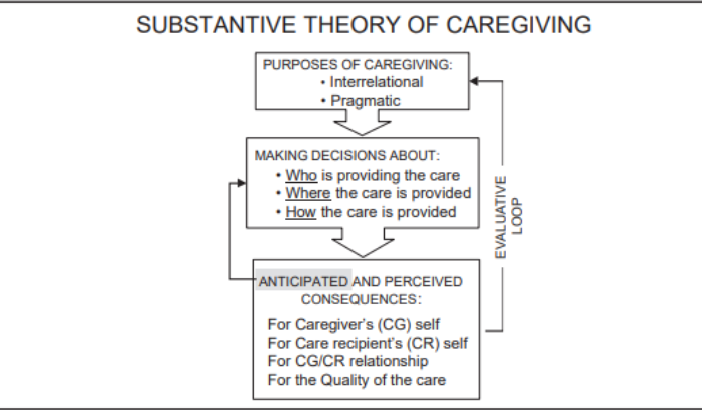
Interrelational Caregiving
Usually when the person being cared for experiences a cognitive loss.
Carers work to strengthen and support the recipient’s sense of self to way things ‘had always been’.
Ensure the recipient has a sense of worth and is able to reciprocate in the relationship – do something for the carer too.
Maintain past role – even if they are unable to complete some tasks.
Pragmatic Caregiving
Sharing the care more – so now the interrelational aspect is handled by HCP.
Now, the carer’s main focus is that the recipient is emotionally and physically comfortable.
Ensures high quality care, lessens the cost of care giving, and ensures the recipient is getting cared for properly (preventing pressure sores, eating well, emotionally happy).
Transactional Model of Stress & Coping (Lazarus & Folkman)
Stress is a dynamic relationship between a person and their environment.
Become stressed when the demands outweigh the resources.
Primary Appraisal (is anything at risk? How bad is it?)*
Secondary Appraisal (Internal coping options and external coping)**
Coping (Problem Focused/Emotion Focused)
What is the biomedical model of pain?
Treating the pain as a pathology itself
What is the Biopsychosocial model of pain?
Origin of pain is complex and multifactorial.
Takes into consideration the psychological and social impact of pain.
What is Operant Conditioning in terms of pain?
Learning through consequences.
Through the concept of negative reinforcement – avoid what gives you pain in order to not feel the pain.
WHat is Psychophysiological Reactivity?
When you feel pain, your body has a physiological response to overcome it.
Tensing muscles in order to stop pain – can be debilitating if continued for too long
Treat with relaxation techniques
WHat is the Cognitive Theory of pain?
Making sense of pain in the surroundings
Pain demands attention and interrupts ongoing activity.
Attempts to prevent pain may result in anxiety = more pain.
As this is a vicious cycle – patients more likely to catastrophise their pain – make it out to be a disaster and so it leads to more pain, more hypervigilant of pain too. Think panic attacks.
Outline the Developmental Model for EMOTION REGULATION AND EATING BEHAVIOURS
Exposure: Exposure to different types of food as kids – lessen neophobia.
Social Learning: Observational learning – children see role models engaging with different food and they too will be likely to engage in eating different foods.
Association: Rewarding eating behaviours seem to increase food preference.
Outline the Weight Concern Model for EMOTION REGULATION AND EATING BEHAVIOURS
Associated with the meanings attached to food, weight, body dissatisfaction and dieting.
THEORY OF PLANNED BEHAVIOUR
1) Starts from the assumption that the strongest determiner of your behaviour is your intentions.
How you intend to behave will be how you actually behave
2) Intentions affected by three factors
Attitudes:
Influenced by beliefs about the outcomes of the behaviour
Evaluation of outcomes.
Subjective norm:
Influenced by perceived beliefs of others
How much the person wants to comply.
Perceived behavioural control:
Determines how easy or difficult it is for the person to complete the task
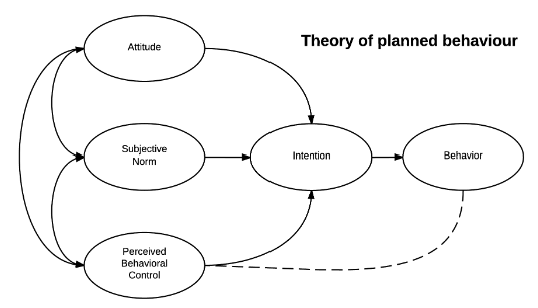
Some pros and cons of the Theory of planned behaviour
Pros:
Takes account the importance of social pressures + norms as well as how much control a person believes they have
Cons:
Focuses more on intentions than behaviours
Assumes you have the opportunities and resources to be successful in that behaviour
Fear, threat, mood and past experience.
HEALTH BELIEF MODEL
1) Perceived Threats:
Perceived threat for chronicity was high, cyclical nature was low and consequences were moderate.
Perceived personal control was high and were usually unaware of the severity of threat.
2) Perceived Benefits:
Compared to non-attenders, high attenders and low attenders still perceived a greater physiological and functional benefit from participating in programmes
Greater social benefits
3) Perceived Barriers:
Accessing health programmes
Travel barriers
4) Cues to Action:
Worry for health
Peer pressure
Family Is a strong cue for action
Emphasise benefits and modify barriers
TRANSTHEORETICAL MODEL OF CHANGE
Model of change that encourages people to change chronic detrimental lifestyles.
Longstanding and addictive behaviour.
Not a linear model of change – can enter and exit any part at any point.
Stage 1: Pre-contemplation
Patient not considering changing behaviour.
Stage II: Contemplation
Patient realises some changes need to be made.
Stage III: Preparation
Patient prepares to change.
Stage IV: Action
Makes change for the short-term.
Stage V: Maintenance
Change for the long-term.
Stage VI: Relapse
Relapse at any time and go through the cycle a few times.
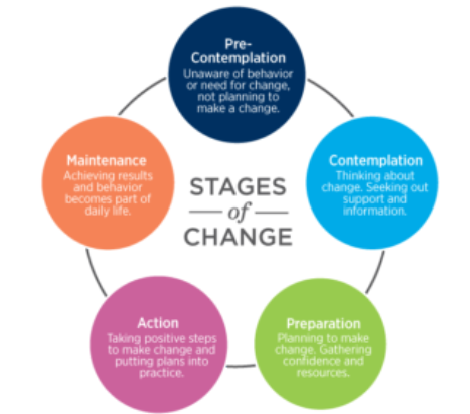
Advantages and disadvantages of the Transtheoretical model of behaviour change
Advantages of the Transtheoretical Model of Change
Recognises that changing behaviour is different for everyone and not a linear process – can move in and out of different stages at any time.
Recognises relapse as part of the process and does not blame person for it.
Disadvantages of the Transtheoretical Model of Change
Precontemplation and contemplation might just be the same.
Go through it many times – time consuming and might get tired of trying.
Requires a motivation.
What is the SOCIAL COGNITIVE THEORY?
a framework for understanding how people learn by observing others and how personal, behavioral, and environmental factors interact to influence learning and behavior.
1. Cognitive (Personal) Factors
These include:
Knowledge – What a person knows.
Expectations – What outcomes they expect from their actions.
Attitudes – How they feel or think about certain behaviors or situations.
These internal processes influence how a person perceives and responds to their environment.
🔶 2. Environmental Factors
These are external influences such as:
Social norms – What’s considered acceptable behavior by society or peers.
Access in community – Availability of resources or opportunities (e.g., access to healthy food, education).
Influence on others – How a person can shape their environment or social surroundings (e.g., peer influence, role models).
🔷 3. Behavioral Factors
These are related to the individual’s actual actions or capabilities:
Skills – The ability to perform certain behaviors.
Practice – Experience gained through repetition.
Self-efficacy – Confidence in one’s ability to perform a behavior successfully.
🔁 The Core Idea:
All three factors interact and influence each other—this is called reciprocal determinism.
For example:
Your beliefs (cognitive) affect how you act (behavior).
Your behavior can change your environment (e.g., joining a group).
Your environment then feeds back and affects your beliefs and actions.
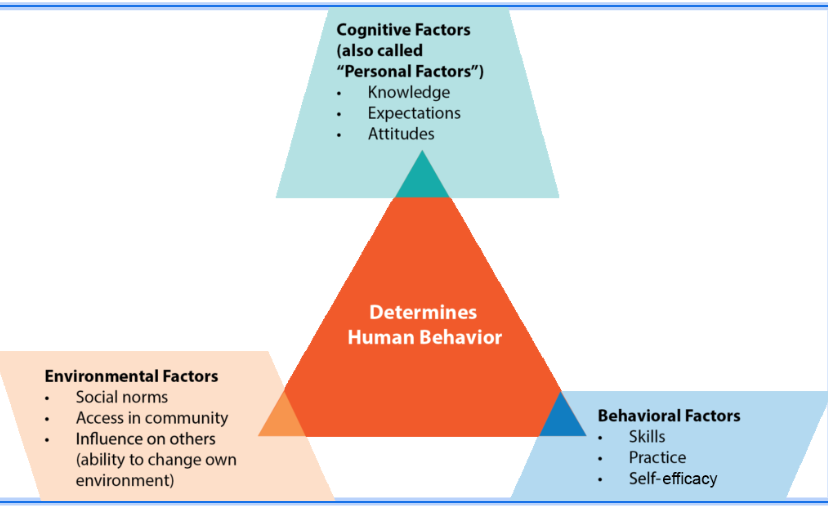
SELF-DETERMINATION THEORY
Suggests that people are motivated to grow and change by three innate and universal psychological needs.
People are able to become self-determined when needs for competence, connection/relatedness and autonomy fulfilled.
Competence:
Sufficient qualities to perform a given task or to describe the state of having sufficient intellect, judgement, skill and strength.
When you are competent, you are able to interact effectively within their environment – environmental mastery.
Relatedness:
Sense of belonging to a social group.
Autonomy:
Able to have choice and govern own behaviour.
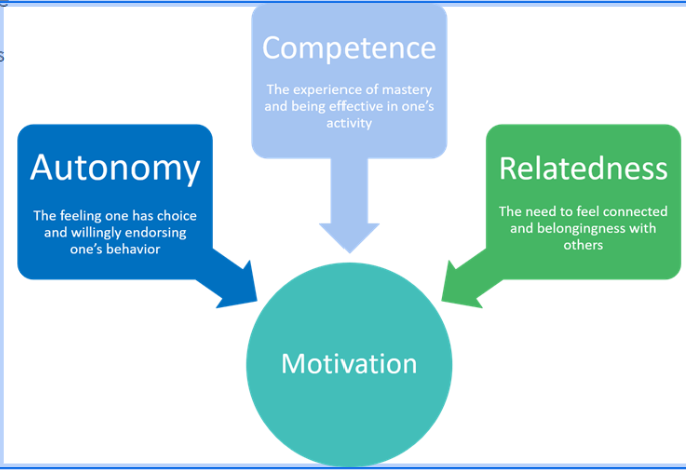
Outline Selye’s GAS Model of Stress
Alarm: Activation of the SNS – short term stressor.
Resistance: Activation of HPA axis – long term stressor (chronic illness).
Exhaustion: Depletion of bodily resources (long term affects of cortisol).
There are two parts of the cycle of stressor-disease relationship
Influence of stress on disease
Disease disrupting the neural and endocrine circuits that mediate the stress response.
Neuropsychiatric symptoms come to light – depression, anxiety, insomnia.
Stress leads to disease and disease leads to stress
Explain Critical Theory
Critiquing and changing socitey as a whole. Focuses on how knowledge and organisation of power can lead to certain groups being subjugated or oppressed. It is concerned with equity and justice.
Explain Professionalism Theory
How occupational groups have exclusive ownership of specific areas of knowledge and expertise. Entry regulations and maintaining standards.
Explain Labelling Theory
Placing a label on someone and understand their deviant behaviours
Negotiated order Theory
Maintains social order with an organisation. Emphasises negotiation through bargaining and compromising which helps create rules and structures.
Name determinants of mental well being
- Under employment
- Food insecurity
- Poor access to healthcare
- Low education
- Poverty
- Poor neighbourhoods
- Social exclusion and inclusion
- Housing instability
- Adverse life experiences
What are the 3 factors that contribute to coping
Individual factors
Family Factors
Environmental Factors
Cognitive Behavioural model of depression
Cognitive Model of Health Anxiety
A previous experience forms a bad memory
You create a schema of that memory – a pocket of information.
Schema affects your view of yourself, the world and the future (Beck’s Cognitive Triad)
When faced with a critical ‘incident’ that coincides with your schema i.e. failed an exam = feeling worthless- this activates your automatic negative thoughts
Negative automatic thoughts lead to behavioural, emotional, cognitive and somatic symptoms.
The more negative you become, the more depressed you become.
Beck’s Cognitive Triad
Kubler-Ross 5 Stages of Grief (DABDA)
Denial
Anger
Bargaining
Depression
Acceptance
Pros and cons of DABDA Kubler-Ross 5 Stages of Grief
Pros:
Understanding AND coping with loss.
Cons:
Assumes set pattern – this is not like the real experience of grief.
Too linear, rigid and passive to be used to describe grief.
Usually used in life-limiting illness and NOT in bereavement.
Freudian Theory of Grief
Grief is a solitary process where mourners withdrew from the world so detachment from the deceased could be a gradual process.
Concept of ‘Grief Work’ where you detach from the deceased and focus on letting them go.
Freudian theory of Grief
Cons:
Only studied people who were depressed so his explanation can only be used with depressed people.
Not applicable to wider population.
Pros:
Confronting grief to allow detachment has remained a feature of subsequent theory and practice.
Lindemann’s 5 Stages of Grief
Somatic distress – Physical symptoms like tightness in the chest, shortness of breath, or loss of appetite.
Preoccupation with the image of the deceased – Constantly thinking about or seeing the lost person in your mind.
Guilt – Feelings of guilt or self-blame (e.g., "I should have done more").
Feelings of hostility and anger
Difficulty carrying out daily activities
Bowlby’s Theory of Attachment
Emphasises the importance of human attachments and bonds formed in early life.
Involves four overlapping, flexible phases:
Shock
Yearning and Protest
Despair
Recovery
Parkes Theory of Grieving
A process rather than a state. Each stage morphs into each other; a continuum.
Shock or numbness
Yearning and pining
Disorganisation and despair
Recovery
Understood that process of grieving is not linear
Recognised grief is not a state, but a process – you cannot be cured from grief, but rather the phases merge and replace one another.
Emphasises emotional and physical effects of anxiety.
Focuses on adults
What is worden AWAW model of grief
Setting tasks that need to be achieved in order to work through grief.
Passive phases replaced by active tasks of mourning.
Task One: Accept reality of loss
Task Two: Work through and experience the pain of grief
Task Three: Adjust to an environment without the deceased person.
Task Four: Withdraw emotionally from or relocate the deceased and move on – relocation focuses on having memories of deceased in a way that you can go about daily life.
Evaluation of Stage Models
Pros
Understand grief in an active way.
Helps understand WHY we grieve – attachment theory in particular.
Patterns and similarities in human behaviour.
Comfort knowing experience is shared by others.
COns:
Grief is a complicated process and there is not one way of feeling grief.
Grief is explained in a linear fashion.
Is there a wrong and right way to grieve?
Western culture – different cultures have different bereavement processes.
Explain the dual process model
The Dual Process Model of Coping with Bereavement, developed by Margaret Stroebe and Henk Schut (1999), describes how people adapt to the loss of a loved one by oscillating between two types of stressors:A bereaved individual as to cope with the experience of death as well as the lifestyle changes that result from it
1. Loss-Oriented Coping
This involves facing the grief directly and dealing with emotions related to the loss.
Activities:
Yearning, remembering, and crying
Talking about the deceased
Experiencing sadness, anger, or guilt
Visiting places or keeping items associated with the person
2. Restoration-Oriented Coping
This involves adjusting to life without the deceased, focusing on practical changes and new roles.
Activities:
Taking on new responsibilities (e.g., finances, childcare)
Forming new routines or identities
Reinvesting in life or forming new relationships
Distraction from grief
3. Oscillation (Key Concept)
The model emphasizes that healthy grieving involves moving back and forth (oscillating) between these two types of coping.
Constant focus on either can be overwhelming or unhealthy.
Oscillation allows for balance—some days are filled with emotional reflection; others are about getting on with life.
Evaluation of the Dual Process Model
Pros and cons
Pros:
Culturally sensitive and flexible – allows an individual experience of grief.
Understand you can move between loss orientated and restoration orientated.
Degree of emphasis on loss orientated or restoration orientated depends on individual.
COns:
Emphasis on coping and adjustment – if this takes long or you are unable to cope or adjust is it abnormal?
No focus on interpersonal relationships within grieving process – how do families interact?
WHat are the 2 ways people adapt to chronic illness?
Illness Related
Dealing with symptoms, disability, medical regimens
Good rship with staff
General
Coping with illness diagnosis
Maintaining a good self image
Keeping social relationships
Preparing for uncertain future
Key aspects of adjustment:
Chronic illness necessitates adjustment in multiple life domains
Involves positive and negative outcome dimensions
Dynamic process
Can be viewed only from within an individual context
Heterogeneity is the rule not the exception
Stress & Coping Model
Adjustment in the face of external stress is influenced by
The individual’s appraisals of stressors
The coping strategies they use for managing these stressors
Their appraisal of the efficacy of the coping strategies used
Processes of adjustment are measured separately from their outcomes
Transactional Model of Stress & Coping (Lazarus & Folkman)
Stress is a dynamic relationship between a person and their environment.
Become stressed when the demands outweigh the resources.
Primary Appraisal (is anything at risk? How bad is it?)*
Secondary Appraisal (Internal coping options and external coping)**
Coping (Problem Focused/Emotion Focused)
Engel’s Biopsychosocial Model
Giving the patient the sense they are being understood by examining the biopsychosocial dimensions of their illness
Livneh & Antonak
Variables associated with chronic illness and disability
Disability related (type/severity)
Sociodemographic factors (age/sex/ethnicity)
Personality (coping mechanisms/locus of control/meaning of condition)
Physical and social environment (social support/stigma)